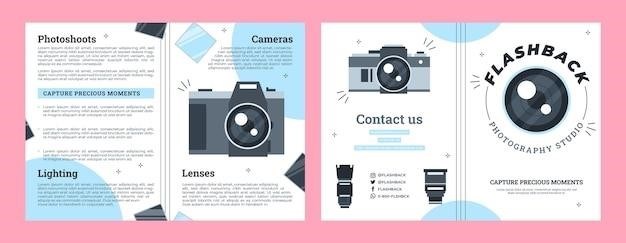Nikon D300 Manual⁚ A Comprehensive Guide
This comprehensive guide provides a detailed overview of the Nikon D300, a popular DSLR camera known for its image quality and advanced features. This manual covers key features, specifications, image quality, autofocus system, exposure modes, white balance, flash settings, memory card compatibility, LCD display, battery life, and troubleshooting tips. Whether you are a beginner or an experienced photographer, this guide will help you understand and maximize the capabilities of your Nikon D300.
Introduction

The Nikon D300, released in 2007, was a groundbreaking DSLR camera that revolutionized the landscape of professional and enthusiast photography. This camera, built with a robust and durable design, aimed to bridge the gap between the high-end professional D3 and the consumer-oriented D80. The D300 was lauded for its impressive 12.3-megapixel resolution, offering exceptional image quality and detail, and a powerful autofocus system that ensured precise subject focus, even in challenging lighting conditions. It was also praised for its advanced features, including an innovative self-cleaning sensor unit, a comprehensive set of exposure modes, and a versatile flash system. The D300 provided photographers with a powerful tool to capture stunning images, and its introduction marked a significant advancement in DSLR technology.
Key Features and Specifications
The Nikon D300 boasts a compelling array of features that cater to both professionals and enthusiasts. At its core lies a 12.3-megapixel DX-format CMOS sensor, renowned for its exceptional image quality, low noise performance, and ability to capture a wide dynamic range. The camera features a robust autofocus system with 51 focus points, ensuring precise subject focus in various shooting scenarios. Its impressive burst rate of 6 frames per second allows photographers to capture fast-moving action with ease; The D300 offers a comprehensive set of exposure modes, including Aperture Priority, Shutter Priority, Manual, and Program, providing flexibility and control over image exposure. Its built-in flash system, with a guide number of 12, complements the camera’s capabilities in low-light conditions. Furthermore, the D300 supports CF, CF Type II, and MicroDrive memory cards, ensuring ample storage space for high-resolution images. The camera’s compact and lightweight design makes it a versatile choice for photographers on the move.
Image Quality and Sensor
The Nikon D300’s image quality is a testament to its advanced technology. At the heart of its imaging prowess lies a 12.3-megapixel DX-format CMOS sensor. This sensor is renowned for its ability to capture exceptional detail, vibrant colors, and a wide dynamic range. Even in challenging lighting conditions, the D300 delivers impressive results, thanks to its low noise performance. The camera’s image processing engine effectively minimizes noise, ensuring clean and sharp images even at higher ISO sensitivities. The D300 offers a range of image quality settings, allowing photographers to select the desired balance between file size and image quality. These settings, including JPEG, NEF (RAW), and JPEG+NEF, enable photographers to tailor their workflow to specific needs. Whether capturing landscapes, portraits, or action shots, the D300’s sensor consistently delivers high-quality images, making it a reliable tool for professional and enthusiast photographers alike.
Autofocus System
The Nikon D300 boasts a sophisticated autofocus system designed to provide fast and accurate focusing in various shooting scenarios. The camera features a 51-point autofocus system with 15 cross-type sensors, offering wide coverage and precise focusing even in low-light conditions. The D300’s autofocus system is renowned for its speed and accuracy, allowing photographers to capture sharp images of fast-moving subjects. The camera’s autofocus modes include Single-servo AF (AF-S), Continuous-servo AF (AF-C), and Manual focus, allowing users to choose the appropriate mode based on their shooting needs. The D300 also offers advanced autofocus settings, such as the ability to select focus points individually, enabling photographers to fine-tune focus for specific compositions. With its advanced autofocus capabilities, the D300 ensures that subjects are consistently in sharp focus, even in challenging situations.
Exposure Modes and Settings
The Nikon D300 offers a variety of exposure modes to suit different shooting situations and photographer preferences. The camera includes the following modes⁚ Aperture-priority AE (A), Shutter-priority AE (S), Manual (M), and Program (P). In Aperture-priority mode, the photographer sets the aperture, and the camera automatically selects the shutter speed for proper exposure. Shutter-priority mode allows the photographer to set the shutter speed, while the camera adjusts the aperture for correct exposure. Manual mode gives the photographer complete control over both aperture and shutter speed. Program mode automatically selects both aperture and shutter speed based on the scene’s lighting conditions. The D300 also provides a range of exposure settings, including ISO sensitivity, exposure compensation, and bracketing. The camera’s ISO sensitivity range spans from 200 to 3200, expandable to 100 and 6400, allowing photographers to adjust sensitivity for different lighting conditions. Exposure compensation allows photographers to adjust the exposure value, making the image brighter or darker. Bracketing allows the camera to capture a series of images with different exposures, ensuring that at least one image is correctly exposed. These exposure modes and settings provide photographers with the flexibility to control the exposure of their images and achieve desired results.
White Balance and Picture Control
The Nikon D300 offers a range of white balance settings to ensure accurate color reproduction under various lighting conditions. The camera provides preset white balance options, including Auto, Incandescent, Fluorescent, Sunny, Shade, Cloudy, Flash, and Manual. Auto white balance attempts to automatically adjust the white balance based on the lighting conditions. Preset white balance options are designed for specific lighting types, such as incandescent light bulbs, fluorescent lights, or sunlight. Manual white balance allows the photographer to set the white balance manually by using a custom white balance reference. The D300 also features Picture Control, a system that allows photographers to adjust the image’s look and feel. Picture Control options include Standard, Neutral, Vivid, Monochrome, and Portrait. Each option offers a different color saturation, contrast, and sharpness level. The camera also allows photographers to create custom Picture Control settings to personalize their image style. These white balance and Picture Control features provide photographers with the tools to achieve accurate color and desired image styles.
Flash Modes and Settings
The Nikon D300 features a built-in flash that can be used to illuminate subjects in low-light conditions. The camera offers various flash modes to control the flash output and achieve different lighting effects. The Auto flash mode automatically activates the flash when needed, while the Red-eye Reduction mode helps to minimize the red-eye effect in portraits. The Slow Synchronization mode allows the photographer to use slower shutter speeds with flash, resulting in a more natural-looking background with a softer light. The D300 also offers a Fill-in flash mode, where the flash is activated to provide additional light to the subject while maintaining a natural-looking background. Additionally, the camera supports external flash units via the hot shoe, providing more flexibility in lighting setups. The photographer can adjust flash compensation to fine-tune the flash intensity, ensuring proper exposure and desired lighting effects. These flash modes and settings give photographers the ability to control the flash output and achieve creative lighting effects.
Memory Card Compatibility
The Nikon D300 is compatible with a variety of memory cards, providing users with flexibility in storage options. It accepts CompactFlash (CF) cards, including CF Type II and MicroDrive cards. This broad compatibility allows users to choose cards with different storage capacities, read/write speeds, and price points to suit their specific needs. The D300 can handle high-resolution images and RAW files efficiently, making it suitable for professional photographers or those who shoot in burst mode. The camera’s memory card slot is located on the side of the body, making it easy to access and replace cards. When choosing memory cards for the D300, it’s important to consider factors such as speed, capacity, and price to find the best balance for your shooting style and budget.
LCD Display and Viewfinder
The Nikon D300 boasts a 3-inch LCD display, providing a clear and bright view of captured images. Its large size ensures comfortable image review and menu navigation. The display offers a high resolution, allowing for detailed viewing of photographs and video recordings. The LCD also features a wide viewing angle, enabling users to comfortably view images from different positions. The D300 also incorporates a viewfinder with a magnification factor of 0.94x, offering a more accurate representation of the scene being photographed. The viewfinder is equipped with a focusing screen, allowing users to precisely focus on their subjects. The D300’s viewfinder also includes a diopter adjustment feature, enabling users to customize the viewfinder to their individual eyesight. This combination of a large, high-resolution LCD and a clear, accurate viewfinder allows users to confidently compose and review their images, ensuring optimal results in various shooting scenarios.
Battery Life and Power Management
The Nikon D300 utilizes an EN-EL3e rechargeable lithium-ion battery, providing ample power for extended shooting sessions. The camera’s battery life is rated for approximately 1,000 shots per charge, depending on usage conditions and settings. To maximize battery life, consider adopting power-saving techniques such as reducing the LCD brightness, turning off the image review function, and minimizing the use of the built-in flash. The D300 also incorporates a power-saving mode that automatically shuts off the camera after a period of inactivity, conserving battery power. For extended shooting, consider carrying spare batteries or using an external battery pack. Additionally, be sure to charge the battery fully before each shooting session and avoid leaving the battery in extreme temperatures, as this can shorten its lifespan. By understanding and implementing these power management tips, you can ensure that your Nikon D300 is always ready to capture those important moments.
Troubleshooting and FAQs
This section addresses common issues and frequently asked questions regarding the Nikon D300. If you encounter any problems, refer to the troubleshooting tips provided in the user manual. For instance, if you’re experiencing issues with the camera’s shutter, check the shutter speed settings and ensure it’s not set to a slow speed that may cause blur. If the camera is not recognizing the memory card, ensure that the card is properly inserted and formatted. Additionally, check the memory card’s compatibility with the D300. If you’re facing difficulties with the autofocus system, verify that the AF mode is selected correctly and that the lens is compatible with the camera. For any persistent issues, consult the Nikon support website or contact a qualified technician. Remember, this manual provides valuable information to help you troubleshoot common problems, but if you encounter any complex technical difficulties, it’s best to seek expert assistance.
